This article was inspired by Jenni Wyrsta’s photo of a dolphin playing with what appears to be a red gurnard, Chelidonichthys kumu. Jenni posted this photo on Facebook on 1st August 2020: –
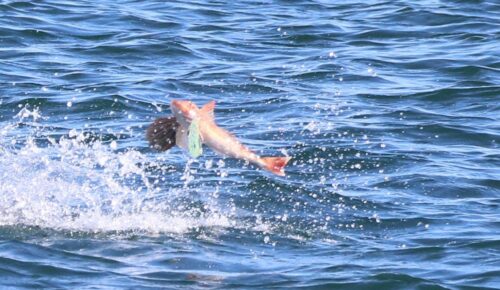
A dolphin playing with what appears to be a red gurnard
(Photo taken by Jenni Wyrsta)
Further investigation revealed that Society member, Wayne Leifert posted some photos of a red gurnard on iNaturalist in 2021. The photos had, however, been taken during a Port Noarlunga twilight dive on 16th March 2018.
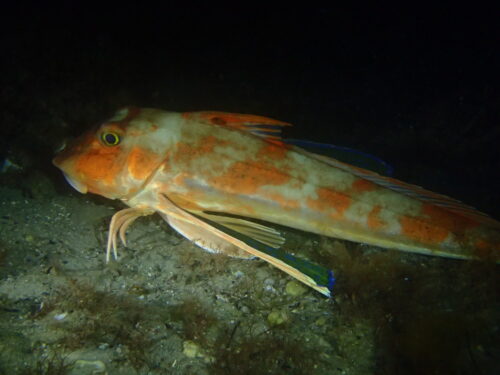
A red gurnard seen during a twilight dive at Port Noarlunga
(Photo taken by Wayne Leifert)
Wayne later commented that the sighting was the “only SA sighting” on record (on iNaturalist?). He also commented on iNaturalist that it was “the scariest fish I have seen, it even attacked me. I don’t have fond memories of this fish, sorry!”
Actually, Wayne’s first thought was that the fish was a Flying Gurnard, Dactylopterus volitans. (There are currently zero records for a Flying Gurnard, Dactylopterus volitans on iNaturalist.) Jeff Johnson soon identified Wayne’s photos as being of a Red Gurnard, Chelidonichthys kumu instead.
I asked Wayne what the story was about this fish attacking him. His response was, “Attacking me? Well, the fish turned around 180 degrees, faced me, I moved backwards, and then suddenly it went straight at me, near my chest. The next minute I was in a cloud of dust under the Pt N jetty, with (my dive buddy) Amy laughing at me.”
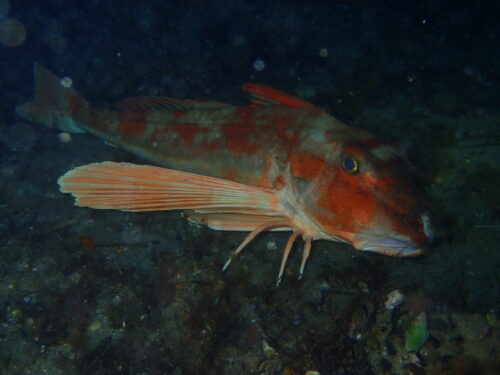
The red gurnard seen during a twilight dive at Port Noarlunga
(Photo taken by Wayne Leifert)
According to iNaturalist, the red gurnard is also known as the bluefin gurnard or Pacific red gurnard: –
“The bluefin gurnard or Pacific red gurnard (Chelidonichthys kumu) is a species of fish in the family Triglidae, the sea robins and gurnards. Its Māori names are Kumukumu and Pūwahaiau. It is found in the western Indian Ocean and the western Pacific Ocean, being common around Australia and New Zealand at depths down to 200 metres (660 ft). This fish is edible for humans.”
Further, “The red gurnard is a bottom-dwelling fish known for its bright red body and large, colorful pectoral fins with a large black eye-spot in the center and surrounded by a bright blue edge (Eichelsheim, 2010; Rainer & Reyes, 2019). Its natural color is a splotchy pale brown, generally only becoming red when stressed and the belly is paler or even white (Lang, 2000).
“It has a boxy, bony head which is protected by backwards-facing spines along the front of the snout and around the eye as well as on the hind margin of the operculum (Ayling & Cox, 1982) and tapers into a laterally elongated body with 33-35 vertebrae.
“There are 8-10 gill rakers and 70-80 scales on its lateral line, which is uninterrupted. Its two tall, triangular dorsal fins have a total of 15-16 soft rays and 9-10 spines. There is no adipose fin. The anal fin has 14-16 soft rays and no spines.
“The red gurnard’s large, fan-like pectoral fins are one of two pairs with 13-14 soft rays and its pelvic fin has 5 soft rays and a single spine. The pectoral fins’ first three rays are modified and separated from the rest of the fin. They are used as sensory organs, sometimes referred to as “fingers” (Powell, 1947), permitting it to probe the sea bottom to detect prey buried in the sand or the mud (Ayling & Cox, 1982; Francis 2012). These spectacular fins make the red gurnard look like a butterfly of the sea, however their role is not entirely known. They could be used to attract a mate or frighten off predators (Ayling & Cox, 1982). These fan-like fins can also be used to give stability during swimming (Francis, 2012).
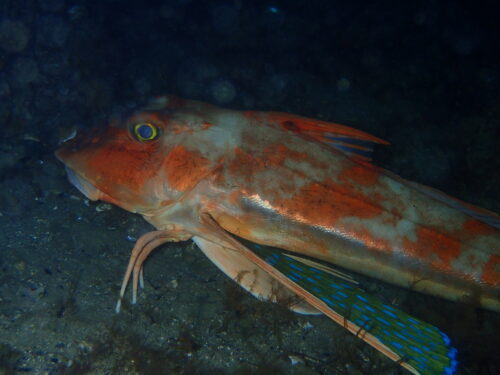
The red gurnard seen during a twilight dive at Port Noarlunga
(Photo taken by Wayne Leifert)
“Distribution – Natural global range
The red gurnard can be found throughout many central tropical and temperate Indo-West Pacific waters (Elder, 1976). It is commonly found along the coasts of New Zealand, Australia, South Africa, and many islands in the South Pacific. It is unsure whether or not previous records from Japan, Korea, China, and the Hawaiian Islands are mis-identifications (NIWA, 2012; Rainer & Reyes, 2019; Roberts, et al., 2015).
“Habitat preferences – As a benthic marine fish, the red gurnard prefers shallow coastal waters and may be found from the edge of continental shelves to estuaries and brackish rivers (MacGibbon & Hurst, 2017) with soft bottoms of sand, sandy-shell, or mud (Eichelsheim, 2010; Elder, 1976). This is because they ‘walk’ slowly over the seabed using their first three free-rays (Francis, 2012). They can bury themselves in the substrate, with only the top of their head, their nostrils and eyes exposed in order to surprise prey (Lang, 2000). It is found from shallow waters one meter deep but generally inhabits 100-200m but may have maximum depths of up to 300m (NIWA, 2012; Rainer & Reyes, 2019).”
I was particularly interested in the words “The red gurnard’s large, fan-like pectoral fins are one of two pairs with 13-14 soft rays and its pelvic fin has 5 soft rays and a single spine. The pectoral fins’ first three rays are modified and separated from the rest of the fin. They are used as sensory organs, sometimes referred to as “fingers” (Powell, 1947), permitting it to probe the sea bottom to detect prey buried in the sand or the mud (Ayling & Cox, 1982; Francis 2012).”
It is later explained on iNaturalist that “The red gurnard is an opportunistic feeder, preying principally on crustaceans but pretty much any small macrofauna such as shrimp/prawns, crabs, crayfish, lobster, amphipods, small fish, and polychaete worms ….. It uses modified fin rays under its pectorals to probe the sand for prey….”.
I was particularly interested in those words in bold, since I had long ago made some comments about the use of those modified fin rays. My comments caused a riff between the late Neville Coleman and myself.
It all started when I reported the sighting of what I thought was a tiny red gurnard at Fishery Beach in December 1983, although I had already suggested that I had possibly seen a red gurnard at O’Sullivan Beach the year before.
I was snorkelling out through the shallows to scuba dive at Fishery Beach when “I noticed an unusual small fish on the sandy bottom. It was a tiny gurnard, possibly a red gurnard. These are said to be common in South Australia, but I think that they live under ledges, and you are lucky to get a glimpse of them. They may cling to the underside of low ledges by way of three feelers which are lower rays completely detached from their large pectoral fins and modified to form feelers.”
Neville Coleman soon sent a letter to me, saying that my comments about the modified fin rays were “absolute nonsense”. I wasn’t convinced though, and quoted Professor Emeritus of Zoology at Munich University, Karl Von Frisch. Page 81 of Frisch’s book “About Biology” said that the rays have become moveable spines which the gurnard crawls along on. There are taste organs at the tips of these spines which the gurnard uses to locate food on the seabed.
(“About Biology” was first published in Berlin in 1959 as “Du Und Das Leben”. It was translated from the German by Elsa B. Lowenstein for the English edition published in 1962.)
I believe that Neville Coleman was concerned about my suggestion that “They may cling to the underside of low ledges by way of three feelers” and he didn’t like me quoting an “Professor Emeritus” in my response. The only certainty now is that “the pectoral fins’ first three rays ….. are used as sensory organs, ….. to probe the sea bottom to detect prey buried in the sand or the mud”.
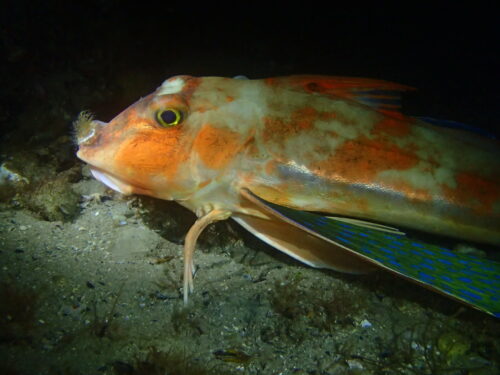
A red gurnard seen during a twilight dive at Port Noarlunga
(Photo taken by Wayne Leifert)
I certainly regretted my conflict with Neville Coleman. I think that he didn’t have much time for me after that.
My “Interesting Sightings” article in our January 1984 newsletter, also stated that the small fish sighted at Fisher Beach “was a sight to see with the way that it swam out in the open using its large wing-like pectoral fins and smaller but still large ventral fins”.
According to iNaturalist, red gurnard “may also use the large fan-like pectoral fins to offer prey mock shelter. A possible use for its large pectoral fins may be to make it appear larger to scare off potential predators (Eichelsheim, 2010)”.
(My thanks go to both Jenny Wyrsta and Wayne Leifert for their red gurnard photos .)


Wayne,Jenni and Steve, what an amazing collaboration!
So many interesting aspects, starting with the fact that a dolphin will play with such a spiny yet tasty fish. I guess dolphins have learned how to prey on red gurnards, by forcing them to the surface where they would be easier to kill without getting jabbed by the spiny bits. Presumably the dolphins would then selectively eat the soft bits and discard the remains,but I am only surmising.
Then there is the attack on Wayne. Presumably a feint , but obviously effective through the element of surprise .And here I should emphasise “Presumably ” because I think at least some of the spiny bits would have venomous slimy coatings if not actual venom glands ,so this species might actually attempt to jab a leading spine in a diver, who will be perceived by the fish as a likely threat.
I can see( = wonder if there are) similarities between this attack episode and the better documented attacks by venomous and spiny estuary cobbler catfish, which I have experienced several times (I got a painful jab in the forearm from an estuary catfish in the Onkaparinga estuary about 2 decades ago and that fish definitely attacked me with the intention of envenoming me, it was not just a feint).
Finally, I might be imagining it (?artefact only) but in the last photo it looks as if the gurnard has a sea anemone on its upper lip. Probably artefact is more likely, eg a bit of loose weed not attached to the fish. But I mention it just in case it really is an anemone, and if so how do we explain it’s presence?
Do red gurnards eat anemones? Do they use them as camouflage or as a form of defence or (let’s get really imaginative!) even as a lure for prey? (analogous to anglerfish??!!).
Enough from me
Dave, some good thoughts there! i also wonder about that final shot. I can’t work out whether the anemone was on the fish or in the background?
Yeah, that’s a tricky question.